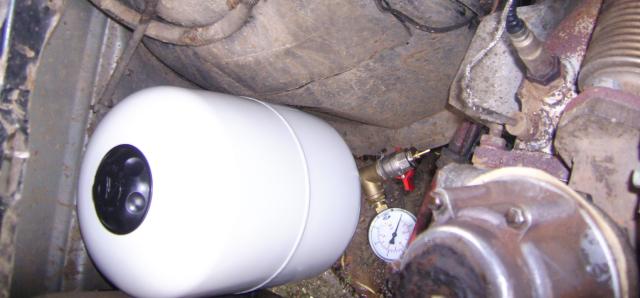Subpage of MembersPage/MarcellGal/PowerAndTraction
We want water injection on this engine.
I filled a 8L pressure tank (rated for 8bar, -10C .. +99C) with water. It fits easily in the empty space of audi's original air-filter. Flowrate will be controlled with PWM valve, using the boostalt output (1.1.50 firmware).

Water level sensing
A system that wants to be foolproof (it won't be) absolutely needs H2O level protection.
First, this system will likely use pressurized tank with pressure sensor. Pressure sensor is good anyway, for compensation (flowrate is normally proportional with sqrt(pressurediff)
Getting water pressure seems to be the expensive part of WI. Not just expensive, but also other sources of risk. The pressurized tank is cheap and failure rate is relatively low.
Antioxidant
Wikipedia writes that besides some alcohol antifreezer, some oil is often mixed (emulged) into the water (not always easy, ultrasonic mixer ?), for anti-oxidant effect to protect injectors
Pressurizing water or windshield washer liquid even away from home
If you find a small 10bar electric pump, let me know
- A steam turbine badly needs it.
- Also, it might be necessary to fill the tank at the racetrack
Options:
- from espresso coffee maker ?
- making it with a high-revving electric motor and a small machined pump ? Centrifugal type pump is easy to make
- The headlight washer pump is not designed for running all day
- but the pump part can be good, with a more robust motor
Filling the pressure water tank
Pressure is up to 4.8bar at the moment (the pressure tank is rated to max 8bar). For some reason it's not even half-filled at this point (can be measured on a baby scale).
I experienced that it cannot be filled via the reverse osmosis filter, because the reverse osmosis filter needs 1.7 bar pressure across it ( 2.8 bar pressure always enough with appr 10L/h according to it's book)
But the simple 20um + carbon + 5um water filter should flow sqrt(pressure diff). Maybe I just didn't wait enough.
Flowrate
I'll need to do flowrate measurements with nozzle, knowing pressure diff and PWM. And VBATT, as VBATT matters at low PWM duty. VBatt makes no diff at 100% PWM duty
TODO: upload image to http://www.vems.hu/gallery/main.php?g2_itemId=41&g2_page=2
The cooler is not ordered yet
To get water into the engine reliably, one needs
- pressure
- on-off solenoid
- It is very important that a solenoid for this is reliable
- a boostcontrol solenoid might suffer corrosion. We don't know
- nozzle(s)
- 2 nozzles have the advantage to supply 3 different amount of fuel at different loads (or 2 different amount if they are equal size, or controlled that way)
Pressure
There are 2 ways to pressurize the system
- pump water
- + small and quiet pump unlike air compressors. Still hard to find for real high (>10bar) pressure, check for ulka coffee machine pumps, http://www.expolygon.hu/files/KVA_Szivattyuk.php
- + ability to produce stable pressure, unlike air-container systems
- + no need for pressurized can (you can reuse even your original windscreen washer can)
- - maybe an 230V inverter necessary for the right pump
- compress air
- this has some huge benefits: if the pump (or the pump supply or relay) fails, some energy is stored in the air so the systems stays pressurized, giving time for the system to lower boost and adjust ignition advance
- easy to store pressure energy for a few minutes of hard running. This would be weight saving for racers. Even for road use, it would be possible to fill with water and air pressure at the same time (it is necessary to fill with water from time to time anyway). In my basement I can fill to 4.8 bar pressure from the water network.
- This eliminates having to have any active pumping device
- the "check-valve" (nipple for the tyre-compressor) can be salvaged from an old rim or bicycle tyre
Nozzle
Good nozzles are essential to
- get good spray pattern, nice mist
- good service lifetime (no corrosion)
Nozzles must inject water after the charge cooler, but before the throttle.
It is generally a bad idea to inject water before the charge cooler. Because water cools the charge, injecting water before the charge cooler makes the delta-T smaller, thus the charge cooler can release less heat (bigger charge cooler needed for same effect).
While it is a good idea to spray water to the outside surface of the charge cooler, it is dumb to spray water to the inside surface. So we will certainly inject after the charge cooler.
Number of nozzles
Water mass - compared to fuel mass (or is the literature usually volume/volume?)
10..15% is the minimum, up to 30% might make sense
I have appr 180L/hour available total fuel injector capacity (with 200+ L/h fuelpump). So 20..40L/h water would make sense
Not sure about optimum though (not possible to fine-adjust anyway)... a 0.35 and a 0.45 mm nozzle would probably do it. TODO: more investigation